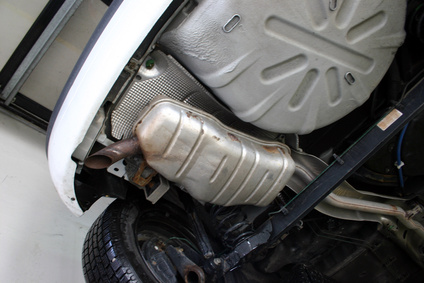Mechanics normally repair vehicles or run diagnostics on them when there is a problem, but mechanics also check new and used automobiles using a complete checklist. Some things a mechanic looks at include the body, wheels and fluids; however, many other parts must be checked as well. Mechanics typically will check a vehicle for insurance purposes or before a sale.

Mechanics should first check the vehicle's body. Look for any body damage, such as scratches, dents or rust. Rust is frequently found under body panels, around lights and in wheel wells. Always check for color differences in the paint. Paint that looks worn in one section but newer in another section may indicate that the vehicle was in an accident. The body of the vehicle may have been bonded and resprayed to mask damage. Some mechanics have electronic tools that can determine if the vehicle was in an accident.

The wheels and tires should be checked by a mechanic to maintain optimum driving performance. The wheels and tires should be inspected for proper inflation and wear, including the spare tire. If the front tires are badly worn, the vehicle's alignment may be off. The treads on all of the tires should be visible. If the tread level is below 1/4 of an inch, then the tire needs to be replaced. The wheels should be checked for cracks, and valve caps should be on all of the valves.

The mechanic should check all of the vehicle's fluids, including the oil, transmission and radiator. Dirty fluids indicate that the car was not maintained on a monthly basis, and that the fluids were not flushed and refilled. The hoses and valves should be checked for leaks or cracks. The rubber hoses leading to the fluid compartments should not have any visible cracking. The valves should be tightly secured to the hoses and compartments. If worn hosing or loose valves are noticed, the mechanic should replace these parts so that the fluids travel through them smoothly. The windshield wiper fluids should also be checked. The mechanic should make sure there is a full quart of wiper solution in the reservoir and use the spray feature to test this function. If the solution sprays evenly on the windshield, then the system is working properly. If the solution does not come out of the nozzles located on the hood of the vehicle, the hoses will need to be replaced.

Inspect all of the glass on the vehicle. Check for hairline fractures or small chips. Glass that has a small chip can be epoxied to prevent the chip from getting larger, but cracked windshields need to be replaced. All of the light covers should be inspected for chips as well. The lights should all be turned on and checked to make sure they work properly.

The mechanic should look over the suspension of the vehicle to see if it has worn out or is malfunctioning. Spring shocks that are worn out need to be replaced. Vehicles with air shocks will either need to have them replaced or have the computer system reprogrammed. Air shocks, normally seen on more expensive models, work with the electronic computer to support the vehicle. The mechanic will check to see if the shocks are worn by firmly pressing down on each corner of the vehicle and quickly letting go. If the vehicle sways up and down consistently, then the shocks will need to be replaced.

The mechanic should finally check the interior. The seat height adjustment controls should be functioning properly as well as the seat belts. The mechanic should turn on the car and make sure all electronics are working, including the lights, instrument panel and radio.

The engine and transmission should be inspected thoroughly. The mechanic should examine all engine components, including the spark plugs, belts and air intake. All of the spark plugs should be tested to make sure they are glowing. The belts should not have any signs of wearing. A worn belt may slip and should be replaced if worn. The air intake filter should be examined for cleanliness. If the air filter is dirty, it should be replaced or recharged with a special cleaning kit. The air intake hose should be inspected for leaks leading to the intake manifold. If the car has a carburetor, it should be cleaned. The transmission should be checked by having the mechanic drive the vehicle to note any harsh shifting. If the vehicle shifts roughly, then the transmission should be further inspected and possibly replaced. Vehicles with a manual transmission should have the clutch checked for wear. Taking the clutch out and inspecting it is not feasible, so the mechanic should drive the car. If the vehicle does not move while in gear quickly or "slippage" occurs, then the clutch should be replaced. The mechanic should also test the car in every gear, ensuring that all of the gears engage correctly.
